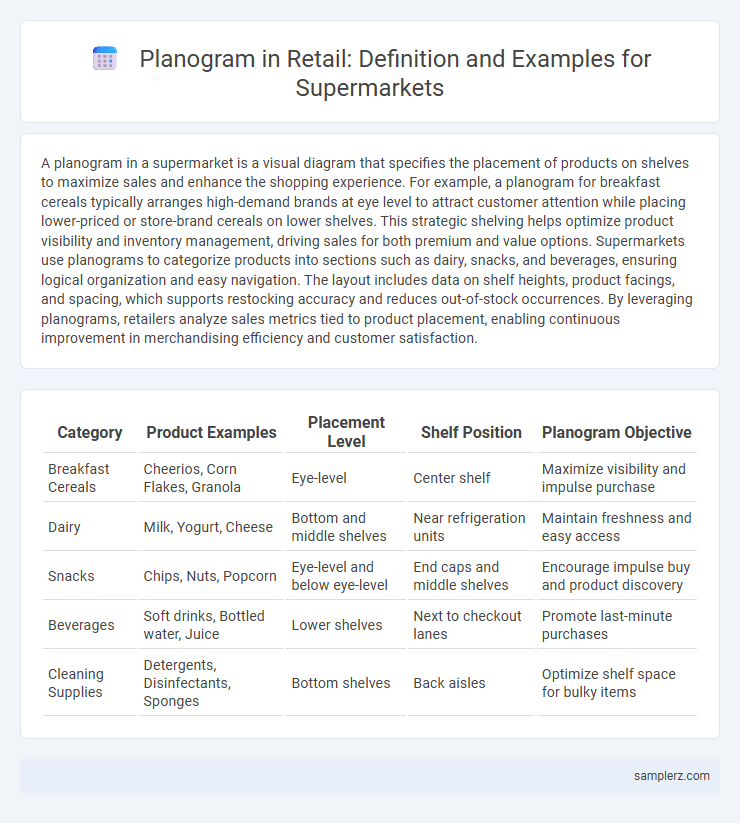A planogram in a supermarket is a visual diagram that specifies the placement of products on shelves to maximize sales and enhance the shopping experience. For example, a planogram for breakfast cereals typically arranges high-demand brands at eye level to attract customer attention while placing lower-priced or store-brand cereals on lower shelves. This strategic shelving helps optimize product visibility and inventory management, driving sales for both premium and value options. Supermarkets use planograms to categorize products into sections such as dairy, snacks, and beverages, ensuring logical organization and easy navigation. The layout includes data on shelf heights, product facings, and spacing, which supports restocking accuracy and reduces out-of-stock occurrences. By leveraging planograms, retailers analyze sales metrics tied to product placement, enabling continuous improvement in merchandising efficiency and customer satisfaction.
Table of Comparison
| Category | Product Examples | Placement Level | Shelf Position | Planogram Objective |
|---|---|---|---|---|
| Breakfast Cereals | Cheerios, Corn Flakes, Granola | Eye-level | Center shelf | Maximize visibility and impulse purchase |
| Dairy | Milk, Yogurt, Cheese | Bottom and middle shelves | Near refrigeration units | Maintain freshness and easy access |
| Snacks | Chips, Nuts, Popcorn | Eye-level and below eye-level | End caps and middle shelves | Encourage impulse buy and product discovery |
| Beverages | Soft drinks, Bottled water, Juice | Lower shelves | Next to checkout lanes | Promote last-minute purchases |
| Cleaning Supplies | Detergents, Disinfectants, Sponges | Bottom shelves | Back aisles | Optimize shelf space for bulky items |
Introduction to Planograms in Supermarkets
Planograms in supermarkets strategically arrange products on shelves to maximize visibility and sales by leveraging consumer behavior insights and product placement analytics. These visual guides detail specific product locations, shelf heights, and quantities to enhance shopper experience and optimize space utilization. Implementing effective planograms increases inventory turnover and supports targeted marketing efforts within retail environments.
Key Elements of a Supermarket Planogram
A supermarket planogram strategically arranges products based on category, brand, and consumer buying behavior to maximize shelf space efficiency and boost sales. Key elements include product facings, shelf height, and placement zones, which are aligned with shopper eye-level preferences and product turnover rates. Color coordination, promotional displays, and appropriate spacing further enhance product visibility and encourage impulse purchases.
Grocery Aisle Planogram Example
A Grocery Aisle Planogram example strategically arranges products such as cereals, canned goods, and snacks by category, brand, and price to maximize shelf space and enhance shopper convenience. Popular items are placed at eye level to increase visibility and drive sales, while complementary products like pasta and sauce are positioned adjacently to encourage cross-selling. Utilizing clear signage and consistent product facings improves organization, streamlines restocking, and boosts overall customer satisfaction in the retail environment.
Beverage Section Planogram Design
A beverage section planogram in a supermarket strategically arranges products like sodas, juices, bottled water, and energy drinks to maximize visibility and sales. Popular brands such as Coca-Cola, Pepsi, Tropicana, and Red Bull are placed at eye level to encourage impulse purchases, while seasonal and promotional items occupy end caps for higher traffic exposure. Shelf heights and product facings are optimized to enhance customer navigation and inventory management efficiency in high-demand areas.
Dairy Products Planogram Illustration
A Dairy Products Planogram in a supermarket strategically positions milk, cheese, yogurt, and butter to maximize visibility and sales. High-demand items like popular milk brands are placed at eye level, while niche products such as lactose-free alternatives occupy adjacent shelves for easy comparison. Optimizing shelf space with clear categorization and brand blocking enhances customer convenience and boosts overall dairy sales performance.
Fresh Produce Planogram Layout
A Fresh Produce Planogram Layout in supermarkets strategically arranges fruits and vegetables to maximize visibility and freshness, often grouping items by color, type, and seasonality to enhance shopper experience. Brightly colored produce like red apples and green bell peppers are positioned at eye level to increase impulse buys, while bulkier items such as watermelons are placed on lower shelves for accessibility. This layout not only supports inventory turnover but also reduces spoilage by facilitating efficient stock rotation and air circulation.
Snack Foods Planogram Organization
A snack foods planogram in a supermarket strategically organizes products to maximize visibility and sales by grouping items such as chips, nuts, and crackers based on brand, flavor, and packaging size. High-demand and promotional snack products are placed at eye level to attract shoppers' attention and encourage impulse purchases. Seasonal and healthy snack options are positioned near checkout aisles to cater to diverse customer preferences while increasing overall basket size.
Best Practices for Supermarket Planogramming
Effective supermarket planogramming arranges products based on consumer shopping behavior and category performance data to maximize shelf visibility and sales. Placing high-demand items at eye level and grouping complementary products together enhances convenience and encourages impulse purchases. Regular analysis of sales metrics and customer flow patterns supports continuous planogram optimization for improved retail outcomes.
Benefits of Effective Planogram Execution
Effective planogram execution in supermarkets maximizes shelf space utilization, leading to increased product visibility and higher sales per square foot. It enhances inventory management by ensuring proper product placement and reducing stockouts or overstock situations. Consumer shopping experience improves as well-organized displays simplify navigation and encourage impulse purchases.
Future Trends in Supermarket Planograms
Future trends in supermarket planograms increasingly incorporate AI-driven analytics to optimize shelf space, enhancing product visibility and consumer purchasing behavior prediction. Dynamic planograms adjust in real-time based on inventory levels, seasonal demand, and shopper demographics. Integration of augmented reality (AR) tools allows retailers to create immersive, interactive shopping experiences that boost customer engagement and sales conversion rates.

example of planogram in supermarket Infographic
 samplerz.com
samplerz.com